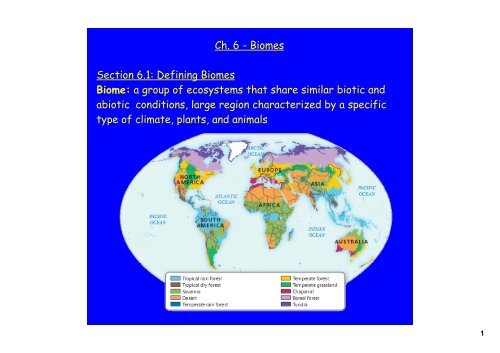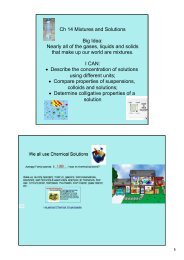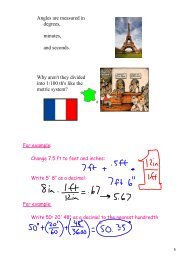Ch. 6 - Biomes Section 6.1: Defining Biomes Biome: a group of ...
Ch. 6 - Biomes Section 6.1: Defining Biomes Biome: a group of ...
Ch. 6 - Biomes Section 6.1: Defining Biomes Biome: a group of ...
You also want an ePaper? Increase the reach of your titles
YUMPU automatically turns print PDFs into web optimized ePapers that Google loves.
<strong>Ch</strong>. 6 - <strong><strong>Biome</strong>s</strong><br />
<strong>Section</strong> <strong>6.1</strong>: <strong>Defining</strong> <strong><strong>Biome</strong>s</strong><br />
<strong>Biome</strong>: a <strong>group</strong> <strong>of</strong> ecosystems that share similar biotic and<br />
abiotic conditions, large region characterized by a specific<br />
type <strong>of</strong> climate, plants, and animals<br />
1
Climate: describes the average condition, including<br />
temperature and precipitation, over long periods in a given<br />
area<br />
Weather: the day-to-day conditions in Earth's atmosphere<br />
Climatographs: climate diagram, shows an area's average<br />
temperature and precipitation<br />
2
Ecologist compare biomes on how productive they are, that is,<br />
how much new organic matter they generate<br />
Net Primary Production: the organic matter, or biomass, that<br />
remains after cellular respiration<br />
<strong><strong>Biome</strong>s</strong> vary in their rates <strong>of</strong> net primary production.<br />
Warm and wet biomes have the highest net primary production,<br />
and cold, dry biomes have the lowest.<br />
4
<strong>Section</strong> 6.2 <strong><strong>Biome</strong>s</strong><br />
Our textbook describes 10 different terrestrial biomes.<br />
Tropical Rain Forest<br />
Tropical Dry Forest<br />
Savanna<br />
Desert<br />
Temperate Rain Forest<br />
Temperate Forest<br />
Temperate Grassland<br />
<strong>Ch</strong>aparral<br />
Boreal Forest (Taiga)<br />
Tundra<br />
These biomes will be covered in your <strong>Biome</strong> Project!<br />
5
Polar Ice: covers the North and South poles <strong>of</strong> Earth<br />
Not considered a biome since they do not have a typical<br />
assortment <strong>of</strong> plants and animals and much <strong>of</strong> the life does<br />
not live on land, but in the water<br />
Animals have developed adaptations to survive in the near<br />
freezing water.<br />
-some fish have "antifreeze" proteins that prevent their<br />
blood from freezing<br />
-mammals, such as seals and whales, have thick fur or<br />
blubber to keep them warm.<br />
6
Mountains: as you go up in elevation, plant communities and<br />
climate change.<br />
Hiking up a mountain is the equivalent <strong>of</strong> passing through<br />
several biomes.<br />
7
<strong>Section</strong> 6.3: Aquatic Ecosystems<br />
Ecologists classify aquatic ecosystems according to criteria<br />
such as salinity, depth, and whether the water is flowing or<br />
standing.<br />
Salinity: measures the amount <strong>of</strong> salt dissolved in water,<br />
measured in parts per thousand (ppt)<br />
Salt water- 30-50 ppt<br />
Brackish water- 0.5-30 ppt<br />
Fresh water- 0.5 ppt or less<br />
8
Depth- photosynthesis by aquatic plants and phytoplankton is mostly limited<br />
by available light<br />
Aquatic Layers<br />
-Photic Zone- uppermost layer <strong>of</strong> an aquatic ecosystyem, where there<br />
is enough light for photosynthesis<br />
-Aphotic Zone- no sunlight penetrates and photosynthesis cannot occur<br />
-Benthic Zone- very bottom <strong>of</strong> a body <strong>of</strong> water, depending on the depth<br />
and clarity <strong>of</strong> the water, benthic zones can be sunlit or pitch dark<br />
9
Freshwater Ecosystems: Ponds, Lakes, Inland Seas<br />
Salinity is less than 0.5 ppt (parts per thousand)<br />
Ponds and lakes are similar, except in size, but inland seas (example- Great<br />
Lakes) contain organisms adapted for open water.<br />
Ponds and lakes are divided horizontally into zones: littoral and limnetic.<br />
Littoral Zone- shallow, near shore, aquatic plants can grow from the<br />
mud and reach the water's surface<br />
Limnetic Zone- farther from the shore, where there is no<br />
rooted plants<br />
10
Freshwater Ecosystems: Wetlands<br />
Areas <strong>of</strong> land flooded with water at least part <strong>of</strong> the year<br />
Include freshwater marshes, swamps, bogs, and fens<br />
Wetlands prevent flooding, recharge aquifers, filter pollutants, and<br />
provide habitats.<br />
12
Freshwater Marshes- shallow-water wetlands typified by tall, grasslike<br />
plants<br />
Swamps- shallow-water, woody shrubs and trees<br />
13
Bogs and Fens- Bogs are wetlands characterized by low nutrients,<br />
acidic water, and thick , floating mats <strong>of</strong> vegetation (usually a type <strong>of</strong><br />
moss). Form from either depressions when water can collect or<br />
secondary succession when a pond is filled in.<br />
Fens are similar, but they are connected to a source <strong>of</strong> groundwater,<br />
tend to be less acidic and more nutrient-rich than bogs.<br />
14
Freshwater Ecosystems: Rivers and Streams<br />
Bodies <strong>of</strong> surface water that flow<br />
downhill, eventually reaching an<br />
ocean or inland sea<br />
Watershed: The area <strong>of</strong> land<br />
drained by a river and its<br />
tributaries<br />
<strong>Ch</strong>aracteristics, such as dissolved<br />
oxygen, temperature, water<br />
speed, organisms, and others,<br />
change from source to mouth.<br />
Flood plain- areas nearest to a<br />
river's course that are flooded<br />
periodically<br />
15
Estuaries<br />
Occur where a river flows into the ocean or an<br />
inland sea<br />
Coastal estuaries are brackish ecosystems;<br />
organisms must tolerate wide salinity and<br />
temperature ranges.<br />
Coastal estuaries are home to salt marshes and<br />
mangrove forests.<br />
Like wetlands, estuaries help prevent flooding<br />
and soil erosion as well as provide habitats.<br />
16
Oceans<br />
Pacific, Atlantic, Indian, Arctic, and Southern Oceans are all connected,<br />
forming a single, vast body <strong>of</strong> water. This one "world ocean" covers 71%<br />
<strong>of</strong> Earth's surface and contains 97.5% <strong>of</strong> its water.<br />
Currents are driven by water temperature and density differences, wind,<br />
and gravity.<br />
Surface winds and heating generate vertical currents that transport<br />
nutrients and oxygen.<br />
17
Upwelling- vertical flow <strong>of</strong> cold, nutrient rich water toward the<br />
surface occurs when horizontal currents diverge (flow away from each<br />
other)<br />
Downwelling- surface water sinks, occurs where currents converge<br />
(come together), transports warm water full <strong>of</strong> dissolved gases to the<br />
ocean depths<br />
18
Horizontal ocean zones: intertidal, neritic, open ocean<br />
Vertical ocean zones: photic, aphotic, benthic<br />
19
Intertidal: Highly diverse; extreme range <strong>of</strong> temperature, moisture, and<br />
salinity<br />
Neritic: Productive kelp forests and coral reefs provide habitats and help<br />
protect shorelines from erosion.<br />
Open ocean: Low productivity due to low light penetration;<br />
phytoplankton base <strong>of</strong> food chain; deep sea organisms and hydrothermal<br />
vent communities<br />
The anglerfish lures prey towards its<br />
mouth with a bioluminescent organ<br />
that protrudes from the front <strong>of</strong> its<br />
head.<br />
20

















